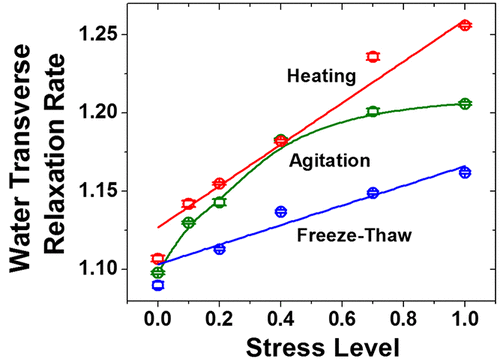当前位置:
X-MOL 学术
›
Anal. Chem.
›
论文详情
Our official English website, www.x-mol.net, welcomes your
feedback! (Note: you will need to create a separate account there.)
Use of Water Proton NMR to Characterize Protein Aggregates: Gauging the Response and Sensitivity
Analytical Chemistry ( IF 6.7 ) Pub Date : 2019-02-15 00:00:00 , DOI: 10.1021/acs.analchem.8b05733 Marc B. Taraban 1 , Roberto A. DePaz 2 , Brian Lobo 2 , Y. Bruce Yu 1
Analytical Chemistry ( IF 6.7 ) Pub Date : 2019-02-15 00:00:00 , DOI: 10.1021/acs.analchem.8b05733 Marc B. Taraban 1 , Roberto A. DePaz 2 , Brian Lobo 2 , Y. Bruce Yu 1
Affiliation

|
Water proton transverse relaxation rate R2(1H2O) measurements by NMR stand out as a powerful noninvasive tool to detect protein aggregates, including subvisible particles in biopharmaceutical formulations. To understand the applicability of water proton NMR (wNMR), we studied the response and sensitivity of wNMR to the aggregates of a monoclonal antibody (mAb) within a wide size range at different aggregate levels, for three different physical stresses: freeze–thaw cycling, heating, and agitation. We compared the sensitivity and response of wNMR with those observed by conventional techniques of size exclusion chromatography (SEC), microflow imaging (MFI), and dynamic light scattering (DLS). Our findings showed that wNMR detects mAb aggregates within wide aggregate levels and in a wide range of aggregate sizes. wNMR was sensitive to an increase in soluble protein aggregates in the range of <1.0%. In most cases, wNMR demonstrated linear response toward the aggregate fraction. Nonlinearity of such response potentially points to the presence of larger size aggregates that possibly rearrange and/or dissociate upon dilution. The results demonstrate the potential of wNMR as a quantitative and noninvasive analytical tool for characterizing protein aggregates in biopharmaceutical formulations.
中文翻译:

使用水质子NMR表征蛋白质聚集体:衡量响应和灵敏度
核磁共振波谱法测量水质子的横向弛豫速率R 2(1 H 2 O)是检测蛋白质聚集体(包括生物药物制剂中的不可见颗粒)的强大无创工具。为了了解水质子NMR(w NMR)的适用性,我们针对三种不同的物理应力,研究了w NMR对宽尺寸范围内,不同聚集水平的单克隆抗体(mAb)聚集体的响应和敏感性。解冻循环,加热和搅拌。我们比较了w的灵敏度和响应NMR具有通过尺寸排阻色谱(SEC),微流成像(MFI)和动态光散射(DLS)的常规技术观察到的那些。我们的发现表明,w NMR可在较宽的聚集体水平和较大的聚集体尺寸范围内检测mAb聚集体。1 H NMR对可溶性蛋白质聚集体的增加范围小于1.0%敏感。在大多数情况下,瓦特NMR证实朝向聚集组分中的线性响应。这种反应的非线性可能表明存在较大尺寸的聚集体,这些聚集体在稀释后可能会重新排列和/或解离。结果证明了w的潜力NMR作为定量和非侵入性分析工具,用于表征生物药物制剂中的蛋白质聚集体。
更新日期:2019-02-15
中文翻译:

使用水质子NMR表征蛋白质聚集体:衡量响应和灵敏度
核磁共振波谱法测量水质子的横向弛豫速率R 2(1 H 2 O)是检测蛋白质聚集体(包括生物药物制剂中的不可见颗粒)的强大无创工具。为了了解水质子NMR(w NMR)的适用性,我们针对三种不同的物理应力,研究了w NMR对宽尺寸范围内,不同聚集水平的单克隆抗体(mAb)聚集体的响应和敏感性。解冻循环,加热和搅拌。我们比较了w的灵敏度和响应NMR具有通过尺寸排阻色谱(SEC),微流成像(MFI)和动态光散射(DLS)的常规技术观察到的那些。我们的发现表明,w NMR可在较宽的聚集体水平和较大的聚集体尺寸范围内检测mAb聚集体。1 H NMR对可溶性蛋白质聚集体的增加范围小于1.0%敏感。在大多数情况下,瓦特NMR证实朝向聚集组分中的线性响应。这种反应的非线性可能表明存在较大尺寸的聚集体,这些聚集体在稀释后可能会重新排列和/或解离。结果证明了w的潜力NMR作为定量和非侵入性分析工具,用于表征生物药物制剂中的蛋白质聚集体。

































 京公网安备 11010802027423号
京公网安备 11010802027423号